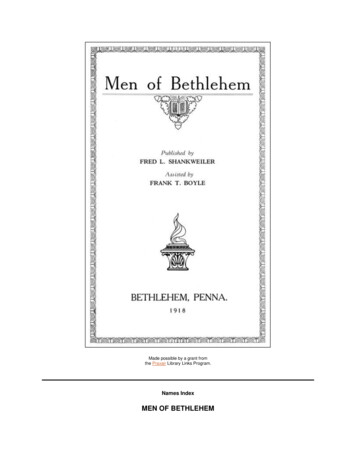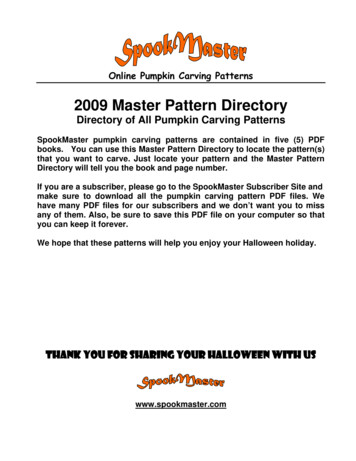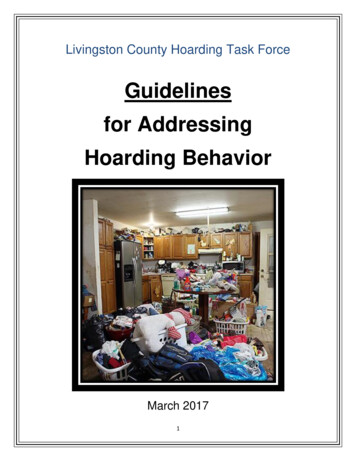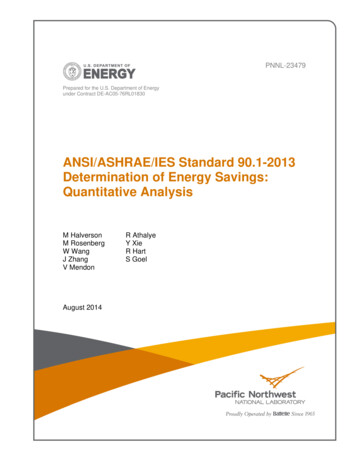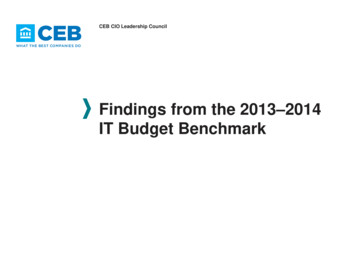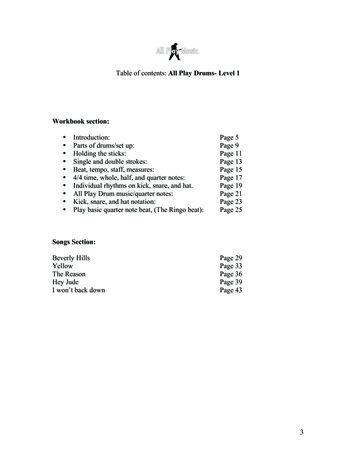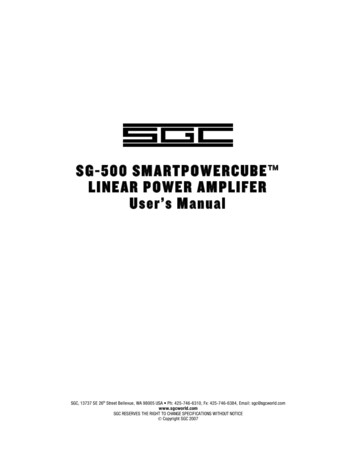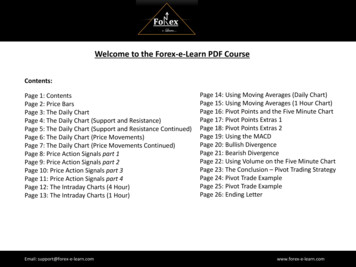
Transcription
Page 1--- F.3d ----, 2013 WL 4610693 (C.A.Fed. (Ill.))(Cite as: 2013 WL 4610693 (C.A.Fed. (Ill.)))Only the Westlaw citation is currentlyavailable.United States Court of Appeals,Federal Circuit.TRADING TECHNOLOGIES INTERNATIONAL, INC., Plaintiff–Appellant,v.OPEN E CRY, LLC, and OptionsXpressHoldings, Inc., Defendants–Appellees,andTradestation Securities, Inc., andTradestation Group, Inc., Defendants–Appellees,andIBG, LLC, Thinkorswim Group, Inc., TDAmeritrade, Inc., TD Ameritrade HoldingCorp., and Interactive Brokers, LLC, Defendants–Appellees,andCQG, INC., and CQGT, LLC, Defendants–Appellees,andFuturepath Trading LLC, Sungard DataSystems, Inc., Sungard Investment Ventures LLC, and GL Trade Americas, Inc.,Defendants–Appellees,andStellar Trading Systems, Ltd., and StellarTrading Systems, Inc., Defendants–Appellees,andEspeed Markets, LP, BGC Capital Markets, LP, and Eccoware Ltd., Defendants–Appellees,andRosenthal Collins Group, LLC, Defendant.No. 2012–1583.Aug. 30, 2013.Background: Patentee brought action alleging infringement of patents for tradingsoftware used to place orders on electronic commodity exchanges. The UnitedStates District Court for the NorthernDistrict of Illinois, Virginia M. Kendall,J., 852 F.Supp.2d 1027, granted summaryjudgment in part against patentee, andthen denied reconsideration and certifiedpartial judgment for immediate appeal,883 F.Supp.2d 772. Patentee appealed.Holdings: The Court of Appeals, Lourie,Circuit Judge, held that:(1) remand was required for district courtto consider whether claims drawn to non“static” display satisfied written description requirement;(2) claims were not invalid for lack of adequate written description; and(3) neither prosecution history estoppelnor prosecution disclaimer applied tocontinuation-in-part patent.Reversed and remanded.West Headnotes[1] Patents 29199291 Patents291IV Applications and ProceedingsThereon291k99 k. Description of Inventionin Specification. Most Cited CasesPatents 291323.2(2)291 Patents291XII Infringement291XII(B) Actions291k323 Final Judgment or Decree291k323.2 Summary Judgment291k323.2(2) k. Presenceor Absence of Fact Issues. Most CitedCasesCompliance with the patent law'swritten description requirement is a question of fact but is amenable to summaryjudgment in cases where no reasonablefact finder could return a verdict for thenon-movingparty.Fed.Rules 2013 Thomson Reuters. No Claim to Orig. US Gov. Works.
Page 2--- F.3d ----, 2013 WL 4610693 (C.A.Fed. (Ill.))(Cite as: 2013 WL 4610693 (C.A.Fed. (Ill.)))Civ.Proc.Rule 56, 28 U.S.C.A.[2] Patents 291168(2.1)291 Patents291IX Construction and Operation ofLetters Patent291IX(B) Limitation of Claims291k168 Proceedings in PatentOffice in General291k168(2) Rejection andAmendment of Claims291k168(2.1) k. In General. Most Cited CasesPatents 291324.5291 Patents291XII Infringement291XII(B) Actions291k324 Appeal291k324.5 k. Scope and Extent of Review in General. Most CitedCasesProsecution history estoppel operatesas a legal limitation on a patentee's abilityto invoke the doctrine of equivalents, andits application is reviewed de novo.[3] Patents 291324.60291 Patents291XII Infringement291XII(B) Actions291k324 Appeal291k324.60 k. Determination and Disposition of Cause. MostCited CasesRemand was required for districtcourt to consider whether claims drawnto non-“static” display, in patent for software employing graphical interface fordisplaying market depth of commoditiestraded on electronic exchanges, satisfiedwritten description requirement.[4] Patents 291159291 Patents291IX Construction and Operation ofLetters Patent291IX(A) In General291k159 k. Extrinsic Evidencein General. Most Cited CasesPatents 291165(3)291 Patents291IX Construction and Operation ofLetters Patent291IX(B) Limitation of Claims291k165 Operation and Effectof Claims in General291k165(3) k. Constructionof Language of Claims in General. MostCited CasesPatents 291167(1)291 Patents291IX Construction and Operation ofLetters Patent291IX(B) Limitation of Claims291k167 Specifications, Drawings, and Models291k167(1) k. In General.Most Cited CasesPatents 291168(2.1)291 Patents291IX Construction and Operation ofLetters Patent291IX(B) Limitation of Claims291k168 Proceedings in PatentOffice in General291k168(2) Rejection andAmendment of Claims291k168(2.1) k. In General. Most Cited CasesIn construing claims, a court seeks todiscern the meaning of a particular termused in one or more claims of a patent,based, inter alia, on evidence drawn fromthe specification, the surrounding claimlanguage, the prosecution history, andrelevant extrinsic sources.[5] Patents 291167(1)291 Patents291IX Construction and Operation of 2013 Thomson Reuters. No Claim to Orig. US Gov. Works.
Page 3--- F.3d ----, 2013 WL 4610693 (C.A.Fed. (Ill.))(Cite as: 2013 WL 4610693 (C.A.Fed. (Ill.)))Letters Patent291IX(B) Limitation of Claims291k167 Specifications, Drawings, and Models291k167(1) k. In General.Most Cited CasesThe patent specification is fundamental to claim construction, as it is thesingle best guide to the meaning of a disputed term.[6] Patents 291167(1)291 Patents291IX Construction and Operation ofLetters Patent291IX(B) Limitation of Claims291k167 Specifications, Drawings, and Models291k167(1) k. In General.Most Cited CasesWhile guided by the specification, thefocus of patent claim construction remains on defining a discrete claim termto better ascertain the boundaries of aclaim; in contrast, the written descriptionanalysis considers the bounds of the specification itself.[7] Patents 29199291 Patents291IV Applications and ProceedingsThereon291k99 k. Description of Inventionin Specification. Most Cited CasesThe written description requirementprevents patentees from claiming morethan they have actually invented and disclosed to the public, as measured by thewritten description of the inventionprovided with their patent applications; inother words, the written description requirement ensures that the scope of theright to exclude, as set forth in the claims,does not overreach the scope of the inventor's patent specification.[8] Patents 29199291 Patents291IV Applications and ProceedingsThereon291k99 k. Description of Inventionin Specification. Most Cited CasesClaims of patent on graphical user interface that could display essential datafrom commodities market and allow userto enter electronic trade orders on exchange reasonably conveyed to thoseskilled in the art that inventor had possession of claimed subject matter as of filingdate, and thus those claims were not invalid for lack of adequate written description, since patent included express descriptions of “static” price axes that couldautomatically re-center based on predefined criteria. 35 U.S.C.A. § 112.[9] Patents 291168(3)291 Patents291IX Construction and Operation ofLetters Patent291IX(B) Limitation of Claims291k168 Proceedings in PatentOffice in General291k168(3) k. Rejection andAmendment of Claims of Particular Patents. Most Cited CasesNeither prosecution history estoppelnor prosecution disclaimer applied tocontinuation-in-part patent for tradingsoftware used to place orders on electronic commodity exchanges that subsequently included extensive disclosuresthat had not been present in predecessorpatents that had prosecution-based restrictions on displays with price axes capable only of manual re-centering, and thatdirectly contradicted prior prosecutionbased surrenders of claim scope; c price axis” claim language of itspredecessors, it differed from predecessorpatents in both its claims and its relevantsupporting disclosures on issue of automatic recentering. 2013 Thomson Reuters. No Claim to Orig. US Gov. Works.
Page 4--- F.3d ----, 2013 WL 4610693 (C.A.Fed. (Ill.))(Cite as: 2013 WL 4610693 (C.A.Fed. (Ill.)))[10] Patents 291168(2.1)291 Patents291IX Construction and Operation ofLetters Patent291IX(B) Limitation of Claims291k168 Proceedings in PatentOffice in General291k168(2) Rejection andAmendment of Claims291k168(2.1) k. In General. Most Cited CasesPatents 291237291 Patents291XII Infringement291XII(A) What Constitutes Infringement291k233 Patents for Machinesor Manufactures291k237 k. Substitution ofEquivalents. Most Cited CasesProsecution history estoppel appliesas part of an infringement analysis to prevent a patentee from using the doctrine ofequivalents to recapture subject mattersurrendered from the literal scope of aclaim during prosecution.[11] Patents 291168(2.1)291 Patents291IX Construction and Operation ofLetters Patent291IX(B) Limitation of Claims291k168 Proceedings in PatentOffice in General291k168(2) Rejection andAmendment of Claims291k168(2.1) k. In General. Most Cited CasesProsecution disclaimer affects patentclaim construction and applies where anapplicant's actions during prosecutionprospectively narrow the literal scope ofan otherwise more expansive claim limitation.[12] Patents 291168(2.1)291 Patents291IX Construction and Operation ofLetters Patent291IX(B) Limitation of Claims291k168 Proceedings in PatentOffice in General291k168(2) Rejection andAmendment of Claims291k168(2.1) k. In General. Most Cited CasesProsecution history estoppel and prosecution disclaimer, though distinct,serve to constrain the enforceable scopeof patent claims commensurate with anysubject matter surrendered during prosecution to obtain the patent; a single actionduring prosecution can engender both aprosecution disclaimer and prosecutionhistory estoppel.[13] Patents 291168(2.1)291 Patents291IX Construction and Operation ofLetters Patent291IX(B) Limitation of Claims291k168 Proceedings in PatentOffice in General291k168(2) Rejection andAmendment of Claims291k168(2.1) k. In General. Most Cited CasesProsecution history estoppel can extend from a parent application to subsequent patents in the same lineage, ascan a prosecution disclaimer, but arguments made in a related application donot automatically apply to differentclaims in a separate application; in general, the prosecution history regarding aparticular limitation in one patent is presumed to inform the later use of thatsame limitation in related patents, unlessotherwise compelled.[14] Patents 291168(2.1)291 Patents291IX Construction and Operation ofLetters Patent 2013 Thomson Reuters. No Claim to Orig. US Gov. Works.
Page 5--- F.3d ----, 2013 WL 4610693 (C.A.Fed. (Ill.))(Cite as: 2013 WL 4610693 (C.A.Fed. (Ill.)))291IX(B) Limitation of Claims291k168 Proceedings in PatentOffice in General291k168(2) Rejection andAmendment of Claims291k168(2.1) k. In General. Most Cited CasesUnder the prosecution disclaimer doctrine, when the purported disclaimers aredirected to specific patent claim termsthat have been omitted or materiallyaltered in subsequent applications, thosedisclaimers do not apply.ati, of Palo Alto, CA, and Natalie J. Morgan, of San Diego, CA. On the brief forCQG, Inc., et al., were Adam G. Kelly,William J. Voller, and J. Simone Jones,Loeb & Loeb, LLP, of Chicago, IL. Onthe brief for eSpeed Markets, LP, et al.,was Gary A. Rosen, Law Offices of GaryA. Rosen, P.C., of Ardmore, PA. On thebrief for TradeStation Securities, Inc., etal., were David J. Healey, Fish &Richardson P.C., of Houston, TX, andAdam Kessel and Kevin SU, of Boston,MA.Patents 291Scott J. Bornstein, Greenberg Traurig,LLP, of New York, NY, for defendants-appellees Open E. Cry, LLC, et al. Withhim on the brief was James J. Lukas, Jr.,of Chicago, IL.328(2)291 Patents291XIII Decisions on the Validity,Construction, and Infringement of Particular Patents291k328 Patents Enumerated291k328(2) k. Original Utility.Most Cited Cases6,766,304, 6,772,132, 7,676,411,7,685,055, 7,693,768, 7,904,374. Cited.Appeal from the United States DistrictCourt for the Northern District of Illinois,in consolidated No. 10–CV0715, VirginiaM. Kendall, Judge.Steven F. Borsand,Trading Technologies International, Inc.,of Chicago, IL, argued for plaintiff-appellant. Of counsel on the brief were LeifR. Sigmond, Jr., Michael D. Gannon,Paul A. Kafadar, and Sarah E. Fendrick,McDonnell Boehnen Hulbert & BerghoffLLP, of Chicago, IL. Of counsel wereJennifer Kurcz and Matthew Sampson.Anthony B. Ullman, Salans LLP, of NewYork, NY, argued for all defendants-appellees. With him on the brief for FuturePath Trading, LLC, et al., was Lora A.Moffatt. Of counsel on the brief werePhilippe Bennett and Aoife Butler, Alston & Bird, LLP, of New York, NY. Onthe brief for IBG, LLC, et al., were Michael Brett Levin and Christopher P.Grewe, Wilson Sonsini Goodrich & Ros-Laura A. Lydigsen, Brinks Hofer Gilson& Lione, of Chicago, IL, for defendantsappellees, Stellar Trading Systems, Ltd.,et al. Of counsel were Ralph J. Gabricand Marc V. Richards.Before LOURIE and PLAGER, CircuitJudges, and BENSON, District Judge.FN*LOURIE, Circuit Judge.*1 In this patent infringement action,Plaintiff–Appellant Trading TechnologiesInternational, Inc. (“TT”) appeals fromthe district court's entry of summaryjudgment that (i) the asserted claims ofTT's U.S. Patents 7,676,411 (the “'411patent”), 7,693,768 (the “'768 patent”),7,904,374 (the “'374 patent”), and7,685,055 (the “'055 patent”) are invalidfor failure to comply with the written description requirement of 35 U.S.C. § 112;and (ii) prosecution history estoppel barsTT from asserting the '055 patent againstsoftware products that include certain display functions. The district courtpremised both holdings on deference toour prior decision in Trading Technolo- 2013 Thomson Reuters. No Claim to Orig. US Gov. Works.
Page 6--- F.3d ----, 2013 WL 4610693 (C.A.Fed. (Ill.))(Cite as: 2013 WL 4610693 (C.A.Fed. (Ill.)))gies International, Inc. v. eSpeed, Inc.,595 F.3d 1340 (Fed.Cir.2010) (“ eSpeed”), which considered two related patentsfrom TT's portfolio.We conclude that eSpeed does not controlthe issues presented in this appeal, andthe district court's rulings based on thatcase are therefore incorrect. Accordingly,and as described more fully below, we reverse and remand for further proceedings.BACKGROUNDA. The TT Patent FamilyTT owns a number of related patents generally directed to software used for electronic trading on a commodities exchange, including the '411, '768, '374,and '055 patents at issue in this appeal.Issued between March 2010 and March2011, those four patents claim priorityfrom U.S. Provisional Patent Application60/186,322, filed on March 2, 2000, andU.S. Patent Application 09/590,692,which was filed on June 9, 2000, andlater issued as U.S. Patent 6,772,132 (the“'132 patent”) on August 3, 2004. The'411, '768, and '374 patents all arose froma series of continuation applicationsstemming from the parent '132 patent.See, e.g., '411 patent, at [63]. Accordingly, the ' 411, '768, and '374 patentsshare a common written descriptionmatching that of the progenitor '132 patent in all material respects. In contrast,the '055 patent traces its priority from the'132 patent as a continuation-in-part, see'055 patent, at [63], and as such, the '055patent contains substantial new matter relative to the original written descriptionof the '132 patent.In general, the subject TT patents concerna graphical user interface that can displayessential data from a commodities marketand allow a user to enter electronic tradeorders on an exchange. Drawings common to the '411, '768, ' 374, and '055 patents exemplify several key aspects of thedisclosed displays: 2013 Thomson Reuters. No Claim to Orig. US Gov. Works.
Page 7--- F.3d ----, 2013 WL 4610693 (C.A.Fed. (Ill.))(Cite as: 2013 WL 4610693 (C.A.Fed. (Ill.)))E.g., '411 patent, figs. 3, 4. Figure 3depicts a trading display that conveys upto-date market information, including thepending bids and offers at various pricepoints. Column 1005, labeled “Prc,” represents various contract prices for thecommodity of interest. Id. col. 7 ll.55–58. Adjacent to the price column arebid and ask columns 1003 and 1004,labeled “BidQ” and “AskQ,” respectively. Those columns show the currentbid quantities (offers to buy) and askquantities (offers to sell) at each price, id.col. 7 ll. 54–55, and a trader can enternew trade orders by clicking on the bidand ask columns, id. col. 10 ll. 19–23.The “inside market,” labeled 1020, spansthe highest current bid price and the lowest current ask price. Id. col. 4 ll. 60–62.In general, the inside market approximates the commodity's market price andtherefore marks a focus of trading activ-ity. In figure 3, the inside market includesa highest bid price of 89 and a lowest askprice of 90.*2 Figure 4 shows the same display,with data for the same market, viewed ata later point in time. '411 patent col. 3 ll.47–48. Over time, the inside market can“ascend and descend as prices in the market increase and decrease.” Id. col. 9 ll.4–5. As illustration, the inside market infigure 4, labeled 1101, has shifted up theprice column to 92/93 from its earlierrange of 89/90 in response to interveningtrades.According to the patents, traders ableto view and quickly appreciate such detailed market data can more readilyidentify (and capitalize upon) developingtrends in an active market. Id. col. 6 ll.12–30. To that end, the disclosed graph- 2013 Thomson Reuters. No Claim to Orig. US Gov. Works.
Page 8--- F.3d ----, 2013 WL 4610693 (C.A.Fed. (Ill.))(Cite as: 2013 WL 4610693 (C.A.Fed. (Ill.)))ical user interfaces offer a logical and intuitive means to convey dynamic marketinformation using bid, ask, and insidemarket indicators that visually track ongoing price fluctuations along the pricecolumn. Moreover, the patents combine amarket grid, a summary of market orders,and an order entry system into a singledisplay. In short, “[s]uch a condenseddisplay materially simplifies the tradingsystem by entering and tracking trades inan extremely efficient manner.” Id. col. 7ll. 40–42.Nonetheless, allowing the inside market to move up and down the displaypresents a problem: “As the market ascends or descends the price column, theinside market might go above or belowthe price column displayed on a trader'sscreen.” Id. col. 9 ll. 15–17. Because theinside market informs most trading decisions, the display must provide a way tore-center the price column and bring theinside market back into view. The parent'132 written description shared by the'411, '768, and '374 patents explains thatthe values in the price column “are static;that is, they do not normally change positions unless a recentering command is received,” id. col. 7 ll. 64–66, and furtherdescribes a “one click” centering featurethat allows a user to re-center the pricecolumn around the inside market with asingle mouse click, id. col. 9 ll. 17–25.B. The eSpeed DecisionAs noted, this appeal is not the first toreach this court concerning TT's tradingsoftware patents. In eSpeed, we considered, inter alia, the correct construction of certain claim terms used in the '132 patent and in another of its manydescendants, U.S. Patent 6,766,304 (the“'304 patent”). The ' 304 patent, like the'411, '768, and '374 patents, shares thewritten description of the parent '132 patent.FN1In eSpeed, TT had asserted claimsfrom the '132 and '304 patents againstseveral providers of electronic tradingsoftware. 595 F.3d at 1347–48. Each ofthe asserted claims required a graphicaluser interface having a “static” display ofmarket price information,FN2 and thedistrict court had construed that term torequire “a display of prices comprisingprice levels that do not change positionsunless a manual re-centering command isreceived.” Id. at 1352. On appeal, TT argued that a “static” price column couldwork with non-manual modes of recentering. Id . at 1353.*3 Relying on the '132 and '304 patents' shared written description, the surrounding claim language, and the relevant prosecution history, we adopted thedistrict court's construction. See id. at1353–55. In particular, we concluded that“[t]he inventors' own specificationstrongly suggests that the claimed recentering feature is manual” because thewritten description “only discusse[d]manual re-centering commands” and referred to “the present invention” as including a manual one-click re-centeringfeature. Id. at 1353–54. Consistent withthat view, we also noted that the claimsof the ' 132 patent recited an additionallimitation stating that the “static” pricedisplay would not move in response tochanges in the inside market, expresslyexcluding displays that re-center automatically when the inside market shifts.Id. at 1354. Finally, we highlighted statements made by the applicants during prosecution. Specifically, the examiner hadfirst considered the term “static display”to be indefinite, but the applicants responded by explaining that the values inthe price column would not change absent a recentering command, and theclaims were then allowed on that basis.Id. at 1354. Accordingly, the full recordbefore us in eSpeed led us to concludethat the proper construction of “static,” as 2013 Thomson Reuters. No Claim to Orig. US Gov. Works.
Page 9--- F.3d ----, 2013 WL 4610693 (C.A.Fed. (Ill.))(Cite as: 2013 WL 4610693 (C.A.Fed. (Ill.)))used in the claims of the '132 and '304patents, required a price column thatmoves only in response to a manual recentering command.In addition, we rejected TT's attemptsto invoke the doctrine of equivalents tofind that products practicing automaticre-centering nonetheless infringed itsclaims to “static” displays. See id. at1355–57. We held that prosecution history estoppel precluded such infringement theories because the applicants hadamended the claims of the '132 and '304patents to make clear that the claimed“static” price levels did not move in response to changes in the inside market,thus “surrender[ing] any subject matterthat moves automatically.” Id. at 1357.Thus, in eSpeed, “both claim constructionand prosecution history estoppel operate[d] . with similar limited results.” Id.C. Prosecution of the '411, '768, '374, and'055 PatentsWhile the eSpeed litigation progressed through the courts, four patentapplications that eventually became the'411, '768, '374, and '055 patents werefiled in the United States Patent andTrademark Office. TT followed two distinct approaches to prosecuting those applications in view of eSpeed. Those approaches are key to the resolution of thisappeal.1. The '411, '768, and '374 ContinuationsWith the applications for the '411,'768, and '374 patents—three parallelcontinuations that relied on the originalwritten description of the '132 patent—TT sought claims that removed theterm “static” from references to the pricecolumn. For example, following the district court's adverse claim constructiondeterminations in the eSpeed litigation,FN3 TT amended the application for the'411 patent. Up to that time, the application had claimed methods requiring“statically” displayed market price information, similar to the claims of the related '132 and '304 patents at issue in eSpeed. But TT's amendment cancelledevery pending claim and introduced newclaims that lacked the term “static” in anyform, and that term remained absent fromthe claims issued in the '411 patent. Inaddition, TT made comparable amendments to the co-pending applications thatgave rise to the '768 and '374 patents.*4 Therefore, while the written descriptions of the '411, '768, and '374 patents match those of the earlier '132 and '304 patents, the claims differ between thetwo groups in at least one key respect—unlike the '132 and '304 patents atissue in eSpeed, the '411, '768, and '374patents claim trading methods and software without limitation to a “static” pricecolumn display.2. The '055 Continuation–in–PartTT pursued a different strategy withthe application for the '055 patent. Thatapplication claimed priority from the '132patent as a continuation-in-part, which allowed TT to add new disclosures to theparent's written description. In part, thoseadditional disclosures were aimed at redefining the term “static” as used in the'055 patent:Certain of the trading tools work particularly well with a trading display thatshows working orders . displayed inassociation with a static price scale oraxis. It is to be understood that, in thiscontext, static does not mean immovable, but rather means fixed in relation.For example, with a static price scale,the scale itself may be movable, but theprices represented remain fixed in relation to each other.'055 patent col. 4 ll. 48–57 (emphasesadded); see also id. col. 25 ll. 4–12 (“Inone embodiment, the trading applicationtracks the market's activity by automatic- 2013 Thomson Reuters. No Claim to Orig. US Gov. Works.
Page 10--- F.3d ----, 2013 WL 4610693 (C.A.Fed. (Ill.))(Cite as: 2013 WL 4610693 (C.A.Fed. (Ill.)))ally centering, for example, the insidemarket . on the display with respect to astatic axis or scale of prices.”); id. col. 26ll. 30–37 (“A trader may use automaticpositioning to always have a visual reference of where the market is trading. Inaddition, automatic positioning may beused in conjunction with manual positioning.”).The claims of the '055 patent likewiserecite steps that include displaying “astatic price axis” and “automatically repositioning the static price axis on thegraphical user interface.” Id. col. 34 ll.15–67. By their terms, the claims of the'055 patent thus require a “static price axis” capable of re-centering via automaticrather than manual commands.D. District Court ProceedingsIn early 2010, TT filed twelve separate infringement actions targeting numerous defendants, including: Open E Cry,LLC; optionsXpress Holdings, Inc.;TradeStation Securities, Inc.; TradeStation Group, Inc.; IBG, LLC; thinkorswimGroup, Inc.; TD Ameritrade, Inc.; TDAmeritrade Holding Corp.; InteractiveBrokers, LLC; CQG, Inc.; CQGT, LLC;FuturePath Trading, LLC; SunGard DataSystems, Inc.; SunGard Investment Ventures LLC; GL Trade Americas, Inc.;Stellar Trading Systems, Ltd.; StellarTrading Systems, Inc.; eSpeed Markets,LP; BGC Capital Markets, LP; Eccoware,Ltd.; and Rosenthal Collins Group, LLC(collectively,“Defendants”).FN4Through a series of supplements andamendments to the original complaints,TT variously accused the Defendants ofinfringing claims from more than ten patents relating to electronic trading software, of which only the '411, '768, '374,and '055 patents are before us in this appeal. The district court consolidated thecases on February 3, 2011. TradingTechs. Int'l, Inc. v. BGC Partners, Inc.,No. 10–cv715 (N.D.Ill. Feb. 3, 2011),ECF No. 70 (Consolidation Order).*5 After consolidation, the partiessubmitted opposing summary judgmentmotions on several issues, includingwhether the claims of the '411 patent satisfied the written description requirementof 35 U.S.C. § 112(a) in light of eSpeedand whether prosecution history estoppelbarred TT from asserting infringementunder the doctrine of equivalents as toproducts with price columns that moveautomatically. Trading Techs. Int'l, Inc.v. BCG Partners, Inc., 852 F.Supp.2d1027, 1029–30 (N.D.Ill.2012) (“SummaryJudgment Order ”).First, the district court concluded thateSpeed required holding the claims of the'411 patent invalid for lack of written description. The court acknowledged thateSpeed did not involve the '411 patent orthe written description requirement andinstead dealt primarily with construingthe term “static” in the claims of the '132and '304 patents. Id. at 1044. Nevertheless, the district court reasoned that eSpeed “made a number of findings regarding the specification in the course of affirming the claim construction that aredispositive here.” Id.According to the district court, eSpeed's construction of “static” in the ' 132and '304 patents turned “on the premisethat the invention described in the specification was limited to static price axesthat move only with manual recentering.” Id. at 1045. Because the '411patent's claims lacked that term andtherefore appeared to cover displays withautomatic re-centering, the district courtconcluded that any decision upholdingthose broader claims as supported by thesame written description “would be atodds with the Federal Circuit's bindingfindings in the eSpeed Decision.” Id. Ingranting the Defendants' motion for summary judgment, the district court ex- 2013 Thomson Reuters. No Claim to Orig. US Gov. Works.
Page 11--- F.3d ----, 2013 WL 4610693 (C.A.Fed. (Ill.))(Cite as: 2013 WL 4610693 (C.A.Fed. (Ill.)))pressly declined to evaluate the parties'evidence or make its own findings on themerits because the court determined “as amatter of law that the eSpeed Decisioncontrols.” Id. at 1038 n. 9; see also id. at1045 n. 13.In addition, the district court held thateSpeed's application of prosecution history estoppel to the '132 and '304 patentsapplied equally to the '055 patent as amatter of law.FN5 The court noted thatthe '055 patent's claims “include the limitation of ‘common static price axis,’ justlike the '304 patent, and flow from . asimilar specification.” Summary Judgment Order, 852 F.Supp.2d at 1046–47.The court then concluded that when “‘multiple patents derive from the sameinitial application, the prosecution historyregarding a claim limitation in any patentthat has issued applies with equal force tosubsequently issued patents that containthe same claim limitation.’ “ Id. at 1046(quoting Elkay Mfg. Co. v. Ebco Mfg.Co., 192 F.3d 973, 980 (Fed.Cir.1999)).TT argued that prosecution disclaimersaffecting the '132 and '304 patents shouldnot automatically limit the '055 patent,with its distinct and contravening additional disclosures, but the district courtdisagreed. “That the '055 patent is only acontinuation-inpart makes no difference.”Id. at 1047 n. 15. The district court therefore held that TT was estopped from asserting that any claims of the '055 patentwere infringed under the doctrine of equivalents by a product with a price axis thatmoves automatically. Id. at 1048.*6 Following the Summary JudgmentOrder, the district court held a statushearing and ordered the parties to file ajoint response summarizing the effe
of Chicago, IL, argued for plaintiff-ap-pellant. Of counsel on the brief were Leif R. Sigmond, Jr., Michael D. Gannon, Paul A. Kafadar, and Sarah E. Fendrick, McDonnell Boehnen Hulbert & Berghoff LLP, of Chicago, IL. Of counsel were Jennifer Kurcz and Matthew Sampson. Anthony B. Ullman, Salans LLP, of New York, NY, argued for all defendants-ap .



